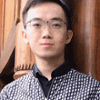417 search results for “cell mobility” in the Student website
-
 Willem Fibbe
Willem FibbeFaculteit Geneeskunde
-
 Dennis Claessen
Dennis ClaessenScience
-
 Micha Drukker
Micha DrukkerScience
-
 Douwe Atsma
Douwe AtsmaFaculteit Geneeskunde
-
 Frank Schaftenaar
Frank SchaftenaarScience
-
 Véronique Ongenae
Véronique OngenaeScience
-
 Christine Mummery
Christine MummeryFaculteit Geneeskunde
-
 Tessa Vergroesen
Tessa VergroesenScience
-
 Ewa Snaar-Jagalska
Ewa Snaar-JagalskaScience
-
 Noortje Dannenberg
Noortje DannenbergScience
-
 Erik Danen
Erik DanenScience
-
 Joost Beltman
Joost BeltmanScience
-
 Arthur Ram
Arthur RamScience
-
 Jason Laffoon
Jason LaffoonFaculteit Archeologie
-
 Floris Keehnen
Floris KeehnenFaculteit Archeologie
-
 Marjolein Crooijmans
Marjolein CrooijmansScience
-
How cells talk by pulling on a fibre network
Mechanics play a larger role in blood vessel formation, and other developmental biology, than previously thought. Cells appear to respond to mechanical signals, such as pressure. Through the extracellular matrix, a network of fibrous proteins, cells can supposedly exchange those mechanical signals over…
-
Bacteria without cell wall gobble up DNA from environment
A bacterium hiding from the immune system and picking up bits of DNA from its environment. The result: gaining new traits, such as better protection against antibiotics. Fortunately, we have not found such a damning scenario yet. However, PhD student Renée Kapteijn did find the first clues, which…
-
forming embryo to cancer metastasis: the significance of collective cell movement
Luca Giomi has the first results of his ERC consolidator grant. He discovered that epithelial cells move collectively but in different ways, depending on the scale you look at. It is hexatic at small scales, and becomes nematic at larger scales: it is a multiscale order. This collective movement of…
-
 Saloni Saxena
Saloni SaxenaScience
-
Stiffness and viscosity of cells differ in cancer and other diseases
During illness, the stiffness or viscosity of cells can change. Tom Evers demonstrated this by measuring such properties of human immune cells for the first time. ‘The stiffness of certain cells could be a way to make a diagnosis,’ Evers said. He defended his thesis on March 26th.
-
First patient in the Netherlands successfully treated with stem cell gene therapy
Researchers from the Leiden University Medical Center (LUMC) have successfully used stem cell gene therapy to treat a baby with the severe congenital immune disorder SCID. An important milestone: it is the first time stem cell gene therapy of Dutch origin has been administered to a patient, and also…
-
How cells determine the fate of proteins (and can we do it too?)
Cells in our bodies are often threatened by errors in our own proteins. The FLOW consortium, comprising scientists from various institutions including Leiden, is poised to meticulously map out for the first time how cells control proteins, correcting or removing faulty ones. This endeavour holds promise…
-
Support the Rapidemic team and help them develop a mobile testing kit
A team of students from Leiden won the iGEM international biology contest in 2020 with their Rapidemic mobile testing kit. The kit makes it easy to detect viruses. The team has now been nominated for the Most Innovative Student in the Netherlands prize. Cast your vote and help them develop their inv…
-
 Serkan Aslan
Serkan AslanScience
-
 Olga Gadyatskaya
Olga GadyatskayaScience
-
 Mette Langbroek
Mette LangbroekFaculteit Archeologie
-
 Francesco Walker
Francesco WalkerFaculteit der Sociale Wetenschappen
-
 Rishuai Chen
Rishuai ChenAfrika-Studiecentrum
-
 Sam Botan
Sam BotanFaculteit Archeologie
-
 Marie Kolbenstetter
Marie KolbenstetterFaculteit Archeologie
-
How to hijack natural destruction in cells: ‘We need to understand it through and through’
Destroying proteins from the Golgi apparatus of the cell in a controlled manner. That is the focus of chemist Marta Artola’s pioneering research. By developing a groundbreaking technology to target specific proteins in the Golgi, Artola aims to unlock new ways for drug development. For this ambitious…
-
Tunnel vision alarm in the search for more efficient hydrogen cells
A tenacious postdoc researcher persuaded Professor Marc Koper to research the oxygen reduction reaction. In Koper's eyes, there was little of interest there. But they promptly discovered a whole new way to improve fuel cells on hydrogen and oxygen. Their article appeared in Nature Catalysis on 07 Ju…
-
electrical stimulation, wearable robots & humans to restore and enhance mobility
Eduard Fosch-Villaronga, Associate Professor at eLaw, contributed to 'Cyber–Physical–Human Systems', a book exploring the latest developments in interactions between cyber–physical systems and humans.
-
Leiden chemists discover new ways in which single-celled organisms organise their DNA
It has only recently been discovered that single-celled organisms (bacteria and archaea) also have histones—proteins that structure DNA. Now, Leiden PhD candidate Samuel Schwab has found that the histones in these organisms are much more diverse than previously thought. Schwab and his colleagues describe…
-
 Remko Offringa
Remko OffringaScience
-
 Joey Zuijdervelt
Joey ZuijderveltScience
-
Innovating Cell Pharmacy with stem cells
Lecture
-
 Jorrit Rijpma
Jorrit RijpmaFaculteit Rechtsgeleerdheid
-
 Corinne Hofman
Corinne HofmanFaculteit Archeologie
-
 Bas ter Braak
Bas ter BraakScience
-
 Herman Spaink
Herman SpainkScience
-
Silver and light: a powerful combination with the potential to save lives
Packages of DNA strands containing silver, measuring just two or three nanometres in size. Leiden physicists Donny de Bruin and Dirk Bouwmeester create these packages, which can enter living cells on their own. They then activate the silver with light, causing the cells to break down. This could, in…
-
 Peter Bouwman
Peter BouwmanScience
-
Erasmus+ for Teaching Assignments
PhD, Staff
-
Erasmus+ for Training
PhD, Staff
-
 Jennifer Swerida
Jennifer SweridaFaculteit Archeologie
-
 Adam Benfer
Adam BenferFaculteit Archeologie
-
LU-Card
All students at Leiden University should have a university ID card, known as a LU-Card.
-
Erasmus+ for Traineeships
Bachelor, Master
